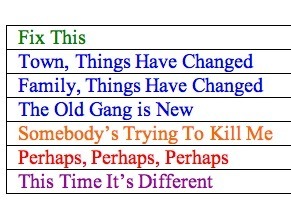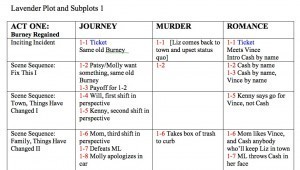What Does It All Mean? (Please, Please Let It Mean Something)
The good thing about naming scene sequences and acts is that it becomes a shortcut to what your story means. After my first drafts, I know what's in my story, and what the plot is about (This is a book about X who wants Y but can't get it because Z), but sometimes I can't see the shape of the plot and what that shape tells me about what the story means. Structure is meaning, always, if you change the structure, you change the meaning. So naming the parts of the structure should boil the meaning of the book down to its essence. If it has an essence. Please let this book have an essence, please, please, please . . .
So start with naming the acts, and you can't name them until you know what they're about so . . .
In Act One, Liz is stuck in her hometown, trying to get out, while people try to pull her back in to fix things.
In Act Two, Liz has agreed to stay for the weekend to help a friend, but she's leaving on Sunday.
In Act Three, there's been a murder and Liz is mad as hell about it and stays to find the killer.
In Act Four, the killer targets Liz and she's fighting for her life and by extension the town she tried to leave in Act One.
Yeah, it took me two years to get that. I'm old.
So . . .
Act One: I'm Not Going To Fix Anything Because I'm Gone
Act Two: I'll Help Out This One Time Because It Changes Things, But Then I'm Gone.
Act Three: I'm Not Letting Anybody Get Away With That
Act Four: You're Going Down, You Bastard
Uh, no. Negative goals. Let's try that again.
Act One: You Can Go Home Again, You Just Can't Leave
Act Two: Always a Maid of Honor, Never an Escapee
Act Three: Attention Must Be Paid
Act Four: Somebody's Out To Get Me And That Stops Now
Uh, no. Not related. One more time.
Act One: Walking Into Trouble
Act Two: Taking Control
Act Three: Fighting Back
Act Four: Defeating the Bad Guy
Nope. That could be any book. One more time:
Act One: Liz comes home and starts a revolution.
Act Two: Liz fixes things and pisses people off.
Act Three: Liz decides the last thing to fix before she leaves is to find the killer.
Act Four: Liz's last attempt at fixing something small becomes a life or death fight to fix something big.
I like that better, it's much more about Liz in action, and escalating, and they're all related, but they're descriptions, not titles. So:
Act One: Broken Home
Act Two: Home Improvement
Act Three: System Failure
Act Four: The Big Fix
Okay, those I like. They're about Liz doing things, they encapsule what happens in the acts, they're related, and they escalate. I can live with those.
Which brings us to the scene sequence titles. In the first act, mine are:
There are really only four kinds of sequences, though.
The first, Fix This in green, is Liz falling back into her old habits of managing things, fixing other people's mistakes, saving people. It comes from both her basic personality and growing up the child of an alcoholic, so it's something she has to come to terms with. It's part of who she is, so it's part of her journey plot, and her attempts to fix things will also motivate a murderer. So the Fix This sequence pretty much propels the Journey plot, but Liz's actions also motivate the Murder plot, and they also establish a bond between her and Vince, the town cop, since they're both Fix It People, so they fuel the Romance Plot, too.
The second Things Have Changed in blue, is about the contrast between the way things were when Liz left home fifteen years ago and the way they are now in the Town, in her Family, and with her Friends. The Town and Family changes are going to motivate Liz to do things differently this time which is also going to motivate the murderer. The Friends changes are more subtle, mostly due to everybody not being teenagers any more, and more powerful because Liz can see what she had all along and where she's made her mistakes. So the Things Have Changed sequences are about the Journey plot, but they also motivate the Murder plot, and since Vince is one of the big changes in the Town, they also motivate the Romance Plot.
The third is Somebody's Trying To Kill Me and it's all about the Murder plot, but it also has an impact on the Journey plot (nothing makes you re-examine your life like a near-death experience) and provides motivation for the Romance Plot.
The fourth, Perhaps, Perhaps, Perhaps, is the Romance Plot, but the romance has a major impact on Liz's Journey and also complicates the Murder Plot (it's harder to kill somebody who hangs out with the cops).
The fifth, This Time It's Different, is really a turning point sequence, Liz's growing determination to fix things erupting in a big way, and since it's a turning point sequence, it affects all three major plots.
So what good does that do me? It sets up the sequences for the next three acts. I have to hit all of those or I've dropped plot arc. They don't have to be in the same order or have the same number of scenes, but I have to hit those titles in each act, in a way that reinforces the title/theme of each act. So I take the scenes I already have written and look at them to see where they fit, or come close to fitting, and then tweak them so that they're part of that scene sequence arc. I can pull out all of the scenes in those sequences across the book and check to make sure that I'm not spinning my wheels, that that list of sequences really does move. It makes the vast number of words in the book organizable, although it would be death to plot this way from the beginning. First the juice, then the glass.
And then, of course, I move to to making sure the six subplots all serve those act and sequence titles while arcing.
So . . .
This book is about Liz who wants to fix what's wrong in her life and in her old home town but can't because there's a homicidal loon on the loose who likes things the way they are.
It's told in four acts:
Act One: Broken Home
Act Two: Home Improvement
Act Three: System Failure
Act Four: The Big Fix
divided into these scene sequences
(Click on the chart to enlarge; there are some blank entries under the Murder column to avoid spoilers, but there's stuff in there, trust me).
I definitely do not do this for every book I write (I'd be insane), but when I've got one that's been off the rails for two years, I do this. As soon as Lavender is finished, I'll do it for You Again because that one is also close to being done and off the rails. This just gives me a map to follow, a sense that I know what I'm doing.
And now, having hopelessly confused and depressed everybody, I'm going back to work.






